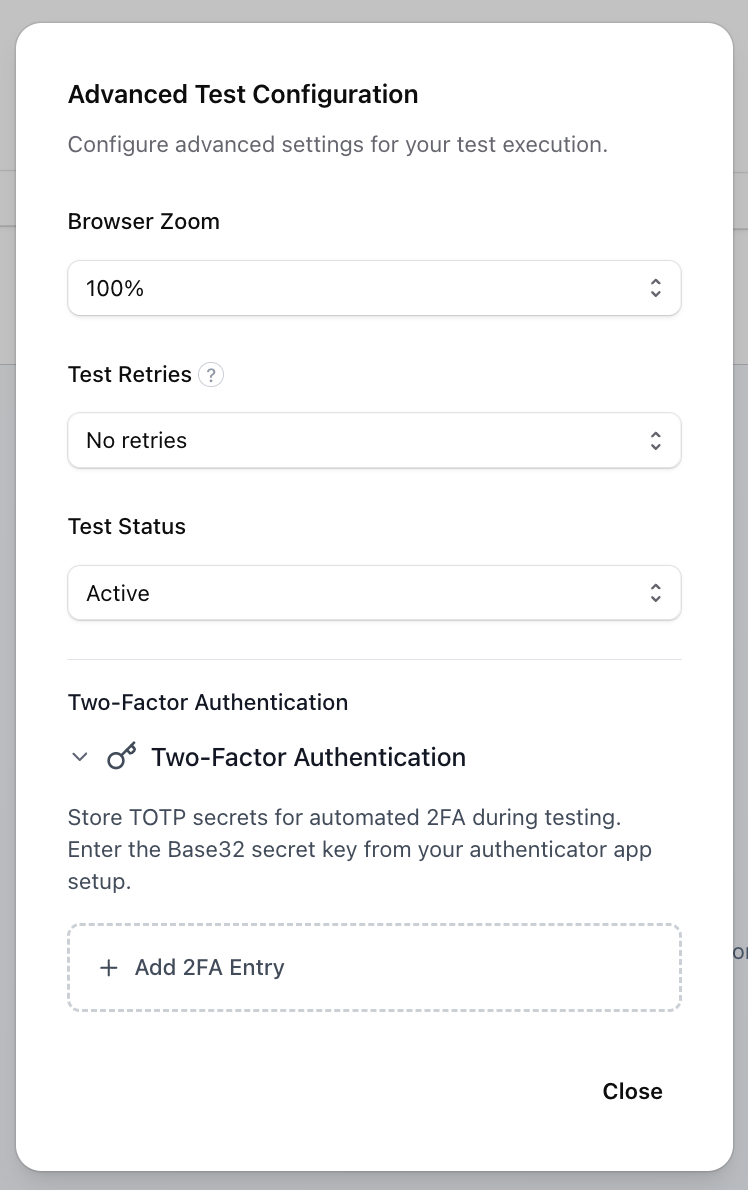Prerequisites
First, go to the test suites page to create a test suite that the test will belong to.Creating a Test
To get started with writing a test on Docket, you should:- Navigate to the tests tab on the left
- Click “Create New Test”
- Enter a title, select a test suite, and provide an entrypoint URL (the starting point for your test)
- Click “Launch Browser”

Building Your Test
To create tests on Docket, you can simply interact in the remote browser and Docket will record actions alongside English annotations automatically. There are three types of steps you can write on Docket:- Cached Steps - Precise coordinate-based actions that replay exactly as recorded
- AI Steps - Natural language instructions that adapt to your UI dynamically
- API Steps - Network requests to endpoints for seeding, setup, and teardown of test resources
API Steps
API steps allow you to make network requests to any endpoint during your test execution. These steps are particularly useful for:- Test Setup: Creating test data, user accounts, or resources before the main test flow
- Test Seeding: Populating databases or systems with necessary data
- Test Teardown: Cleaning up resources after test completion
Test Variables
Docket supports two types of variables that can be used to make your tests more dynamic and reusable. Variables can be created in the Variables tab of the test and inserted into your test instructions by pressing the@ key while writing.

Text Variables
Text variables are simple placeholders that get replaced with their configured values when your test runs. They’re ideal for making tests flexible and reusable across different environments or scenarios. Common use cases:- Credentials: Usernames and passwords when not using the accounts feature
- Test data: Product names, user IDs, or any values that you might want to change often
Email Variables
Email variables are more sophisticated and generate a unique mailbox for each test run using plus addressing. This creates a dedicated email address that the agent can monitor during that specific test execution. Key features of email variables:- Unique per run: Each test execution gets its own email address (e.g.,
baseaddress+unique123@domain.com) - Agent accessibility: The agent can only check emails sent to this specific unique address during the test run
- Full address reference: You can reference the complete generated email address in your instructions when you need to input it into forms
@registration_email would be replaced with the unique email address generated for that test run, and the agent would monitor only that specific mailbox for incoming emails.
Random Alphanumeric Variables
Random alphanumeric variables generate unique random strings (letters and numbers) for each test run. You can set the length and toggle between uppercase/lowercase letters. Perfect for unique usernames, product IDs, or any data that needs to be different every time. Example usage:Using Variables in Instructions
To insert variables while writing test steps: just reference the variable using “@variable_name” and Docket will auto-populate it during runtime. Variables make your tests more maintainable and allow you to easily run the same test logic with different data across multiple environments or scenarios.Learn more: For detailed guidance on writing assertions and understanding AI steps, see the AI Steps documentation.
Advanced Test Configuration
Configure additional settings to fine-tune your test execution behavior.
Browser Zoom Level
Control the browser’s zoom level (equivalent toCtrl +/- in Chromium). Useful for testing responsive design and accessibility.
Options: 50%, 75%, 100% (default), 125%, 150%, 200%
Test Retries
Configure automatic retries when a test fails. Docket will re-run the entire test from the beginning. Options: No retries (default), 1-3 retriesTest Status
- Active (default): Test runs in all scenarios
- Paused: Test is excluded from scheduled runs, CI/CD, and group executions

